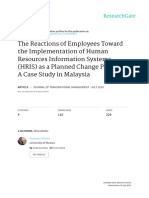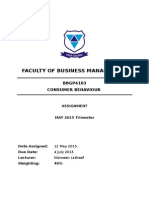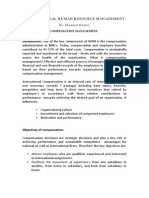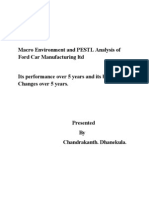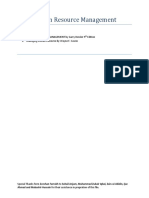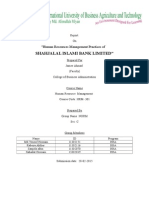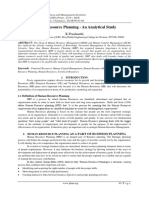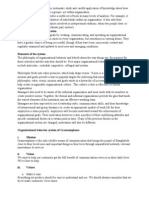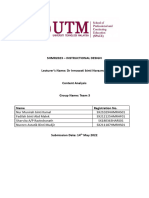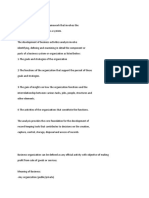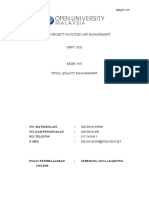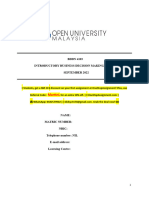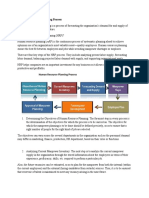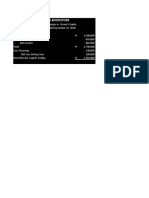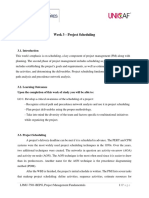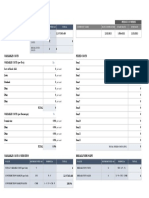Professional Documents
Culture Documents
Human Resource Planning Process
Human Resource Planning Process
Uploaded by
G & E Apparel100%(1)100% found this document useful (1 vote)
264 views3 pagesHuman Resource Planning Process involves 7 steps: 1) Determining objectives, 2) Analyzing current manpower inventory, 3) Forecasting demand and supply, 4) Analyzing manpower gaps, 5) Developing an employment/action plan, 6) Training and development, and 7) Appraising the process. The goal is to forecast an organization's needs for and supply of human resources to have the right number and skills of people for each job.
Original Description:
Original Title
plan 5
Copyright
© © All Rights Reserved
Available Formats
DOCX, PDF, TXT or read online from Scribd
Share this document
Did you find this document useful?
Is this content inappropriate?
Report this DocumentHuman Resource Planning Process involves 7 steps: 1) Determining objectives, 2) Analyzing current manpower inventory, 3) Forecasting demand and supply, 4) Analyzing manpower gaps, 5) Developing an employment/action plan, 6) Training and development, and 7) Appraising the process. The goal is to forecast an organization's needs for and supply of human resources to have the right number and skills of people for each job.
Copyright:
© All Rights Reserved
Available Formats
Download as DOCX, PDF, TXT or read online from Scribd
Download as docx, pdf, or txt
100%(1)100% found this document useful (1 vote)
264 views3 pagesHuman Resource Planning Process
Human Resource Planning Process
Uploaded by
G & E ApparelHuman Resource Planning Process involves 7 steps: 1) Determining objectives, 2) Analyzing current manpower inventory, 3) Forecasting demand and supply, 4) Analyzing manpower gaps, 5) Developing an employment/action plan, 6) Training and development, and 7) Appraising the process. The goal is to forecast an organization's needs for and supply of human resources to have the right number and skills of people for each job.
Copyright:
© All Rights Reserved
Available Formats
Download as DOCX, PDF, TXT or read online from Scribd
Download as docx, pdf, or txt
You are on page 1of 3
Human Resource Planning Process
The Human Resource Planning is a process of forecasting the
organization’s demand for and supply of manpower needs in the near future.
Human Resource Planning Process
1. Determining the Objectives of Human Resource Planning: The
foremost step in every process is the determination of the objectives for
which the process is to be carried on. The objective for which the
manpower planning is to be done should be defined precisely, so as to
ensure that a right number of people for the right kind of job are
selected.
The objectives can vary across the several departments in the
organization such as the personnel demand may differ in marketing,
finance, production, HR department, based on their roles or functions.
2. Analyzing Current Manpower Inventory: The next step is to analyze
the current manpower supply in the organization through the stored
information about the employees in terms of their experience,
proficiency, skills, etc. required to perform a particular job.
Also, the future vacancies can be estimated, so as to plan for the
manpower from both the internal (within the current employees) and the
external (hiring candidates from outside) sources. Thus, it is to be
ensured that reservoir of talent is maintained to meet any vacancy
arising in the near future.
3. Forecasting Demand and Supply of Human Resources: Once the
inventory of talented manpower is maintained; the next step is to match
the demand for the manpower arising in the future with the supply or
available resources with the organization.
Here, the required skills of personnel for a particular job are matched
with the job description and specification.
4. Analyzing the Manpower Gaps: After forecasting the demand and
supply, the manpower gaps can be easily evaluated. In case the
demand is more than the supply of human resources, that means there
is a deficit, and thus, new candidates are to be hired.
Whereas, if the Demand is less than supply, there arises a surplus in
the human resources, and hence, the employees have to be removed
either in the form of termination, retirement, layoff, transfer, etc.
5. Employment Plan/Action Plan: Once the manpower gaps are
evaluated, the action plan is to be formulated accordingly. In a case of a
deficit, the firm may go either for recruitment, training, interdepartmental
transfer plans whereas in the case of a surplus, the voluntary retirement
schemes, redeployment, transfer, layoff, could be followed.
6. Training and Development: The training is not only for the new joinees
but also for the existing employees who are required to update their
skills from time to time.
After the employment plan, the training programmes are conducted to
equip the new employees as well as the old ones with the requisite skills
to be performed on a particular job.
7. Appraisal of Manpower Planning: Finally, the effectiveness of the
manpower planning process is to be evaluated. Here the human
resource plan is compared with its actual implementation to ensure the
availability of a number of employees for several jobs.
At this stage, the firm has to decide the success of the plan and control
the deficiencies, if any.
Thus, human resource planning is a continuous process that begins with the
objectives of Human Resource planning and ends with the appraisal or
feedback and control of the planning process.
You might also like
- Operating Model Canvas: How To Deliver Great Value To Your Customers and BeneficiariesDocument32 pagesOperating Model Canvas: How To Deliver Great Value To Your Customers and Beneficiariestdeviyan0% (1)
- BIM and Big Data For Construction Cost ManagementDocument46 pagesBIM and Big Data For Construction Cost ManagementBaki YoungNo ratings yet
- BBRS4103 - Marketing ResearchDocument12 pagesBBRS4103 - Marketing ResearchZafei ArsyadNo ratings yet
- Planned Change Resistance Malaysia AirlinesDocument18 pagesPlanned Change Resistance Malaysia Airlinesyueniese lNo ratings yet
- Chapter 1 Innovation ManagementDocument21 pagesChapter 1 Innovation ManagementAnis Fatihah100% (1)
- MGTDocument9 pagesMGTNurul IzzatyNo ratings yet
- How Does Performance Management Affect Workers ? Beyond Human Resource Management and Its CritiqueDocument10 pagesHow Does Performance Management Affect Workers ? Beyond Human Resource Management and Its CritiqueNastea NeburacNo ratings yet
- Strategic Management of Malaysian AirlineDocument7 pagesStrategic Management of Malaysian AirlineGeneisseNo ratings yet
- Presentation Induction Quaity NewDocument31 pagesPresentation Induction Quaity Newkbldam71% (7)
- Ecornell Brochure EmailDocument7 pagesEcornell Brochure EmailTunggalNo ratings yet
- Basic Cost ConceptsDocument20 pagesBasic Cost ConceptsBhushan Volvoikar0% (2)
- Factors Affecting The Academic Course Choice of Accountancy, Business and Management Students in Their Academic Performance at Tanauan City CollegeDocument19 pagesFactors Affecting The Academic Course Choice of Accountancy, Business and Management Students in Their Academic Performance at Tanauan City CollegeJomel Serra Briones43% (7)
- HR Assignment-Factors Affecting HR ForecastingDocument3 pagesHR Assignment-Factors Affecting HR ForecastingYared AshagreNo ratings yet
- Assignment - Consumer BehaviourDocument7 pagesAssignment - Consumer BehaviourNor Rohaiza AbbasNo ratings yet
- ApolloDocument27 pagesApolloI don't know100% (1)
- Ethical Issues in HRDocument2 pagesEthical Issues in HRNixon GeorgeNo ratings yet
- Group Assignment 2 (Report) HRM554 - Group 3Document9 pagesGroup Assignment 2 (Report) HRM554 - Group 3Mohd Rozi AmbranNo ratings yet
- BBGP4103Consumer Behaviour Assignment May-2015Document6 pagesBBGP4103Consumer Behaviour Assignment May-2015Diabolus Aggelos ObsidianNo ratings yet
- Chap - 6 Compensation ManagementDocument12 pagesChap - 6 Compensation ManagementshrikantNo ratings yet
- Macro Environment and PESTL Analysis of Ford Car Manufacturing LTDDocument18 pagesMacro Environment and PESTL Analysis of Ford Car Manufacturing LTDShakeeb AhmedNo ratings yet
- HRM Group AssignmentDocument8 pagesHRM Group AssignmentVishal KrishnaNo ratings yet
- Case Study:PTPTNDocument2 pagesCase Study:PTPTNhannoryNo ratings yet
- TQM Case Study - Newspaper Focuses On Customer Service PDFDocument4 pagesTQM Case Study - Newspaper Focuses On Customer Service PDFgigipapasNo ratings yet
- Define Human Resource Management: Part-ADocument4 pagesDefine Human Resource Management: Part-AR.K.BavathariniNo ratings yet
- BBGP4103 Consumer BehaviourDocument6 pagesBBGP4103 Consumer Behaviournartina sadzilNo ratings yet
- Mba Semester 1: Mb0043 Human Resource Management 3 Credits (Book Id: B0909) Assignment Set - 1Document17 pagesMba Semester 1: Mb0043 Human Resource Management 3 Credits (Book Id: B0909) Assignment Set - 1Mohammed AliNo ratings yet
- 11th Malaysia Plan (Latest)Document5 pages11th Malaysia Plan (Latest)ARIFNo ratings yet
- Human Resource ManagementDocument13 pagesHuman Resource ManagementKshipra PanseNo ratings yet
- HRM LecturesDocument17 pagesHRM LecturesPinto ModakNo ratings yet
- HRM Report On Sjibl by IubatDocument23 pagesHRM Report On Sjibl by IubatShahadatHossainShakil100% (1)
- Human Resource Planning - An Analytical Study: K.PrashanthiDocument6 pagesHuman Resource Planning - An Analytical Study: K.PrashanthiRyaz Ahamed100% (1)
- Effect of Succession Planning Strategies On The Sustainability of Family Businesses in NigeriaDocument21 pagesEffect of Succession Planning Strategies On The Sustainability of Family Businesses in Nigeriaclementobata1979No ratings yet
- AirAsia ZitaDocument15 pagesAirAsia ZitaLavarn PillaiNo ratings yet
- Nature and Importance of TraningDocument5 pagesNature and Importance of Traningarpit vermaNo ratings yet
- Tutorial On Chap 9 & 10 Hrm648Document4 pagesTutorial On Chap 9 & 10 Hrm648Aina AmnaniNo ratings yet
- Assignment Principle of Management BBPP1103Document12 pagesAssignment Principle of Management BBPP1103MOHAMAD HAMIZI BIN MAHMOOD STUDENTNo ratings yet
- Human Resource Management and Inter-Group InterventionsDocument12 pagesHuman Resource Management and Inter-Group InterventionsSuman Preet KaurNo ratings yet
- Psychological Skills in Work PlaceDocument22 pagesPsychological Skills in Work PlaceInnocXnt KhanNo ratings yet
- Organizational Behavior Is The Systematic Study and Careful Application of Knowledge About How PeopleDocument5 pagesOrganizational Behavior Is The Systematic Study and Careful Application of Knowledge About How PeopleepsbdNo ratings yet
- Content Analysis-Group 3Document6 pagesContent Analysis-Group 3Nur MunirahNo ratings yet
- Case Study KMDocument3 pagesCase Study KMAnonymous uxd1yd67% (3)
- Human Resource PlanningDocument11 pagesHuman Resource PlanningMarissa AdraincemNo ratings yet
- BBPB 2103 Human ResourseDocument9 pagesBBPB 2103 Human ResourseAttenuator JamesNo ratings yet
- Imr 652Document4 pagesImr 652Anim 97No ratings yet
- Ebqm 3103 - Total Quality ManagementDocument12 pagesEbqm 3103 - Total Quality ManagementSITI NOOR AZLYNEI BT RAMLI STUDENTNo ratings yet
- BBPR 2103 Planning Recruitment and Selection of HRDocument7 pagesBBPR 2103 Planning Recruitment and Selection of HRalistairNo ratings yet
- Wa0013Document3 pagesWa0013kd vlogsNo ratings yet
- Occupational Safety and Health Management at Mopani MinesDocument16 pagesOccupational Safety and Health Management at Mopani MinesChalihjunior ENo ratings yet
- Module 2 HR PlanningDocument16 pagesModule 2 HR PlanningAya moftahNo ratings yet
- Discuss Your Understanding of Business Ethics and Corporate Social ResponsibilityDocument22 pagesDiscuss Your Understanding of Business Ethics and Corporate Social ResponsibilityNabiil PurdasyNo ratings yet
- Tugasan I (BBPS4103) Submit by 4 Nov 2019Document5 pagesTugasan I (BBPS4103) Submit by 4 Nov 2019Jamuna RaniNo ratings yet
- FinalDocument13 pagesFinalKhaled KalamNo ratings yet
- Strategic Human Resource Development - AssignmentDocument14 pagesStrategic Human Resource Development - Assignmenteddiegriffith999No ratings yet
- Pib19063 - Case QCCS at Syarikat SDN BHDDocument4 pagesPib19063 - Case QCCS at Syarikat SDN BHDFAZIELLA MUSA100% (1)
- Construction of A Culture Web: Organizational Development & ChangeDocument14 pagesConstruction of A Culture Web: Organizational Development & ChangeYeshNo ratings yet
- Human Resource ManagementDocument22 pagesHuman Resource ManagementKEDARANATHA PADHYNo ratings yet
- Introduction To HR:: Human Resource Management (HRM), A Relatively New TermDocument23 pagesIntroduction To HR:: Human Resource Management (HRM), A Relatively New TermMurali Krishnan0% (1)
- Human Resources: Ethnocentric OrganisationDocument5 pagesHuman Resources: Ethnocentric OrganisationsohamsitanshuNo ratings yet
- BDDN 4103 Introductory Business Decision Making 9Document11 pagesBDDN 4103 Introductory Business Decision Making 9dicky chongNo ratings yet
- HRM ModelsDocument6 pagesHRM ModelshannaNo ratings yet
- IncentivesDocument27 pagesIncentivesNiwas BenedictNo ratings yet
- Assignment POM (AEON)Document4 pagesAssignment POM (AEON)maizatul athirahNo ratings yet
- Maf671 - Case SummaryDocument9 pagesMaf671 - Case SummarySheikh Are-kimNo ratings yet
- Main Business and IFA IMPIANADocument7 pagesMain Business and IFA IMPIANAAlia NursyifaNo ratings yet
- Human Resource Planning ProcessDocument7 pagesHuman Resource Planning ProcessFiker Er MarkNo ratings yet
- Definition Human Resource PlanningDocument19 pagesDefinition Human Resource Planningrohin gargNo ratings yet
- Sss Services: Income Statement For The Year Ended December 31,201ADocument1 pageSss Services: Income Statement For The Year Ended December 31,201AG & E ApparelNo ratings yet
- NovelaDocument1 pageNovelaG & E ApparelNo ratings yet
- PS Music Journal Entries For The Month of July Date Account Title Post Ref. Debit Credit 11 31Document3 pagesPS Music Journal Entries For The Month of July Date Account Title Post Ref. Debit Credit 11 31G & E ApparelNo ratings yet
- OlleDocument1 pageOlleG & E ApparelNo ratings yet
- Comparative Advantage: Increased Efficiency of Trading GloballyDocument2 pagesComparative Advantage: Increased Efficiency of Trading GloballyG & E ApparelNo ratings yet
- Characteristics of PlanningDocument2 pagesCharacteristics of PlanningG & E ApparelNo ratings yet
- Cost Accounting Level 3/series 3-2009Document19 pagesCost Accounting Level 3/series 3-2009Hein Linn Kyaw100% (2)
- Strategy Analysis and ChoiceDocument12 pagesStrategy Analysis and ChoiceAsif Ali100% (1)
- Appinfo Log - PreviousDocument165 pagesAppinfo Log - PreviousRolandCNo ratings yet
- Quality AssuranceDocument39 pagesQuality AssuranceSherylleen RodriguezNo ratings yet
- Business Details of TREEBO FRANCISEDocument4 pagesBusiness Details of TREEBO FRANCISEAmirul Mostafa ArefeenNo ratings yet
- Pao 2018-02 GastpeDocument109 pagesPao 2018-02 GastpeFitz BaniquedNo ratings yet
- The Relative Importance of The PMBOK Guide's Nine Knowledge Areas During Project PlanningDocument34 pagesThe Relative Importance of The PMBOK Guide's Nine Knowledge Areas During Project PlanningPanashe ChikomweNo ratings yet
- Assignment 1Document15 pagesAssignment 1219152477No ratings yet
- Week 3 - Project SchedulingDocument7 pagesWeek 3 - Project Schedulingمعتز محمدNo ratings yet
- ACCT 1003 Summary Notes 1Document4 pagesACCT 1003 Summary Notes 1roy JohnsonNo ratings yet
- Controlling: Components of Organizational Control SystemsDocument2 pagesControlling: Components of Organizational Control SystemsMichelle PalconNo ratings yet
- Barilla SpA Case SlidesDocument23 pagesBarilla SpA Case SlidesBhavik MehtaNo ratings yet
- Introduction: Data Analytic ThinkingDocument38 pagesIntroduction: Data Analytic ThinkingGökhanNo ratings yet
- International Marketing MixDocument47 pagesInternational Marketing MixJeremiah CharlesNo ratings yet
- Introducing Knowledge ManagementDocument17 pagesIntroducing Knowledge ManagementWailNo ratings yet
- 5522-Business Policy & StrategyDocument12 pages5522-Business Policy & Strategysohailshahsyed8680No ratings yet
- 10 Activity 1Document3 pages10 Activity 1Hanna LyNo ratings yet
- Filemon G. Tercero For Petitioner. The Government Corporate Counsel For Republic Planters BankDocument8 pagesFilemon G. Tercero For Petitioner. The Government Corporate Counsel For Republic Planters BankCorina Jane AntigaNo ratings yet
- Break-Even Analysis: Variable Costs Fixed CostsDocument1 pageBreak-Even Analysis: Variable Costs Fixed CostsBacarrat BNo ratings yet
- Business Development Director in Detroit MI Resume Murray DavisDocument2 pagesBusiness Development Director in Detroit MI Resume Murray DavisMurray DavisNo ratings yet
- Masters Timetable V7 Updated 23-08-2019 Modification To Exam Dates (MECN7000, 7007A, 7016A, 7017A, 7020A)Document2 pagesMasters Timetable V7 Updated 23-08-2019 Modification To Exam Dates (MECN7000, 7007A, 7016A, 7017A, 7020A)LungisaniNo ratings yet
- Physical Test Qualified CandidatesDocument76 pagesPhysical Test Qualified CandidatesMuhammad AadilNo ratings yet
- Cost Accounting PracticalsDocument12 pagesCost Accounting Practicalsjohn hellNo ratings yet
- ACT 141-Module 1-Assurance ServicesDocument98 pagesACT 141-Module 1-Assurance ServicesJade Angelie FloresNo ratings yet



